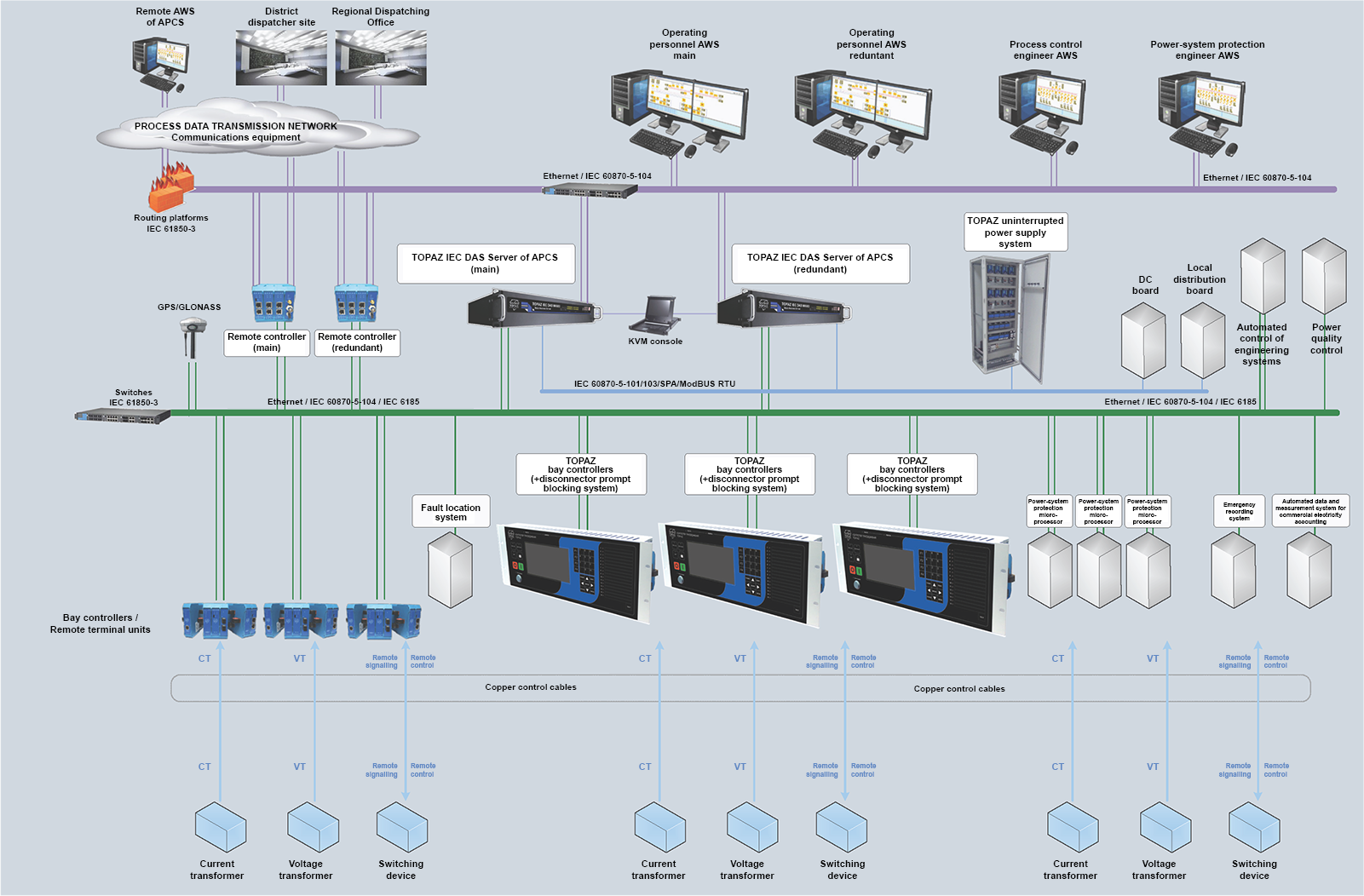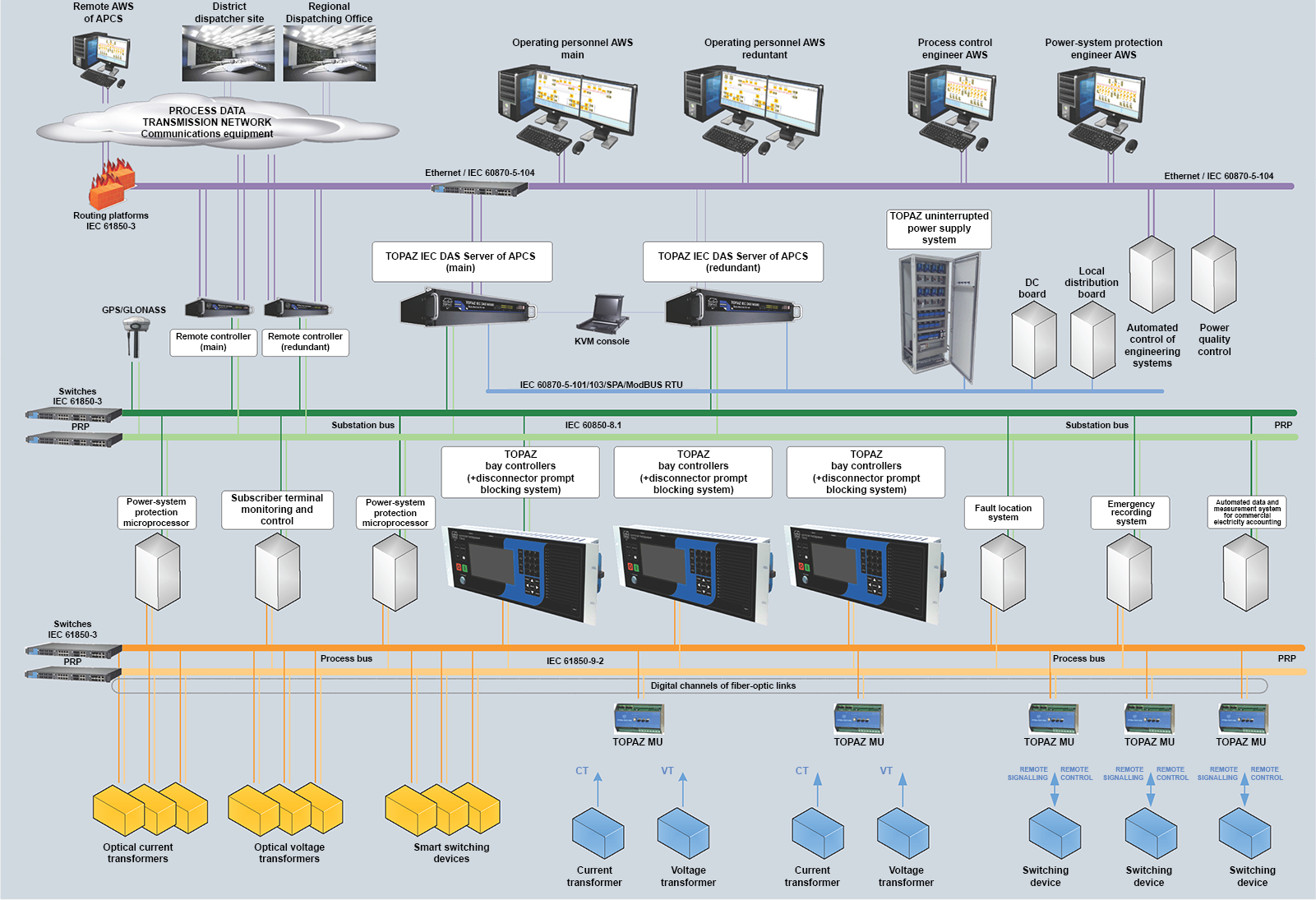
The TOPAZ software and hardware system is developed based on the IEC 61850 standard. It is designed to create automated systems for power facilities (automated process control systems for substations, data acquisition and transmission systems, process information acquisition and transmission systems, remote control systems, process control automated systems, etc.).;
The TOPAZ software and hardware system is developed based on the IEC 61850 standard. It is designed to create automated systems for power facilities (automated process control systems for substations, data acquisition and transmission systems, process information acquisition and transmission systems, remote control systems, process control automated systems, etc.).
The automated process control system based on the TOPAZ software and hardware system provides comprehensive process automation and improves reliability, safety, and operational efficiency of the substation equipment and its adjacent electrical network segments by minimizing the number of required substation staff.
The automated process control system based on the TOPAZ software and hardware system is a three-level system for monitoring and control based on the series of IEC 61850 standards.
The system comprises a hot standby configuration for critical components.
The top level includes:
● data (server) concentration, processing and backup units, for example, TOPAZ IEC DAS MX820;
● user input/output devices (automated workplaces, printers):
● operating personnel's automated workplace (main and standby workplace);
● automated workplace of the power-system protection engineer (fixed);
● process control engineer's automated workplace (fixed and portable).
● In addition, the software and hardware tools of the automated process control system provide remote authenticated access to the system from the "remote access server" workplace
The middle level of the system comprises:
● data transmission devices (TOPAZ FW routing platforms, TOPAZ SW switches, etc.) to organize the substation's standby data network based on the principle of redundant topology;
● live data servers that support transmission of remote control data to upper levels of dispatcher control (data acquisition and transmission systems);
● clock synchronization device TOPAZ Metronome PTS;
Data transmission via GSM-GPRS channels is also supported using TOPAZ GSM routers and TOPAZ IEC DAS controllers.
The bottom level comprises primary sources of measurement and discrete data as well as operational units (TOPAZ TM, TOPAZ MC, TOPAZ MU series of devices):
● microprocessor units for data acquisition and processing (bay controllers and remote terminal units that perform the following:
● conversion of discrete and analog data into digital format, including support of the IEC 61850-9-2 protocol;
● digital input of discrete and analog data from specialized controllers included in DC boards and local distribution board equipment, etc.;
● provision of data to consumers using the IEC 61850-8-1 protocol;
● remote control commands (to operational units) via a digital protocol.
The automated process control system also includes:
● core (firmware) and application (user) software;
● uninterrupted power supply units;
● temperature sensors;
● structures for housing technical equipment (cabinets with the necessary hardware, furniture for automated workplaces);
● maintenance equipment and spare parts.
The IEC 61850-8-1 protocol is used for data exchange between the components of the automated process control system.
Data exchange with microprocessor devices of related IT systems and automated process control systems is performed in digital form using standard international protocols.
Data exchange between the automated process control system and systems of the upper control level is performed using the standard IEC 60870-5-104 protocol.
Electrical equipment and engineering subsystems of substations comprise controllers that use different communication protocols (other than IEC 61850-8-1).
These controllers are integrated via the information acquisition and processing devices of the automated process control system that use the IEC 61850-8-1 protocol.
To arrange physical channels between the automated process control system components, fiber optic and wire cables are used.
Redundant physical channels are provided for connecting critical devices of the automated process control system as well as for connecting groups of devices.
Servers of the automated process control system are redundant; each of them has two hot standby power supply units connected to individual power sources.
Data are stored using SCSI/SAS/SATA drives combined into a RAID logical unit.
Servers include a redundant Ethernet interface connected to different LAN switches.
Operator and engineering workstations are equipped with SATA drives combined into the Level 1 RAID unit.
Workstations include a redundant Ethernet interface connected to different LAN switches.
Monitors at the operator and engineering workstations are the main tools for displaying current information to users.
The workstations use high-resolution color 24" LED monitors.
Operating personnel's automated workplaces are equipped with two monitors.
Workstations use Windows OS.
Features of the automated process control system based on the TOPAZ software and hardware system:
DATA FEATURES
1. Organizing and maintaining a real-time process database updated at the process performance speed.
2. Collecting and primary processing of analog and discrete signals.
3. Warning and emergency alerts.
4. Calling up hardware and software tools (emergency indicator) from a process screen for each connection.
5. Event recording.
6. Historical data backup, storage, and viewing.
7. Information processing, creating historical data reports and saving them to a special offline database.
8. Working with related system databases.
CONTROL FEATURES
1. Remote control.
2. Prompt blocking control.
3. Software blocking.
4. Blocking signal transmission from devices in repair.
5. Manual or automatic replacement of remote signaling/measurement data, including input of disconnector and isolator switch positions (pseudo remote signaling), and sending the data to dispatch centers.
6. Setting up various levels of custom performance limits.
7. Installing warning and prohibiting signs on mnemonic diagrams, temporary ground (signs), and bus isolation.
SYSTEM-WIDE FEATURES
1. System maintenance and administration of the software and hardware system.
2. Access control and management for users of the software and hardware system.
3. Automatic diagnostics of the communication link to devices at a lower level of the software and hardware system and issuing alerts when communication to a device fails.
4. Support of the SNMP protocol at the middle and upper levels for monitoring network devices.
5. Synchronizing components of the software and hardware system using signal receivers of the GPS system or GLONASS/GPS receivers.
Support of synchronization via NTP, SNTP, IRIG-B, PPS, and other protocols.
INTEGRATION WITH POWER-SYSTEM PROTECTION AND AUTOMATIC EMERGENCY RESPONSE SYSTEMS
1. Reading current measurements and updating their values in the process database.
2. Reading remote control signals and updating their values in the process database of the software and hardware system.
3. Recording events from signals received from controllers and microprocessor units of the power-system protection and automatic emergency response systems.
4. Automatic collection of oscilloscope records.
5. Reading and managing groups of preset values.
6. Reading short circuit currents.
Sample automated process control system of a modern 35–220 kV substation based on the TOPAZ software and hardware system

Sample automated process control system of a digital 35–220 kV substation based on the TOPAZ software and hardware system
